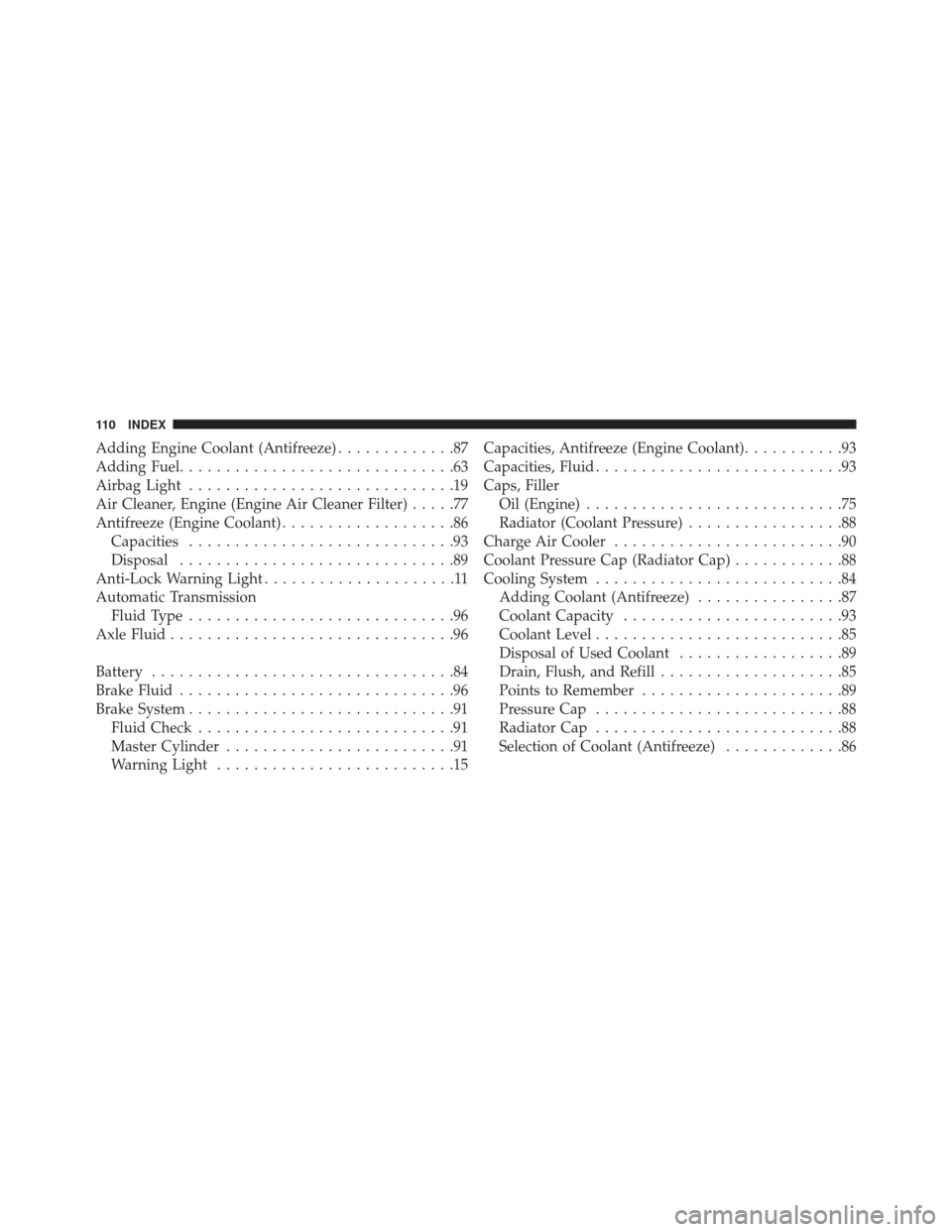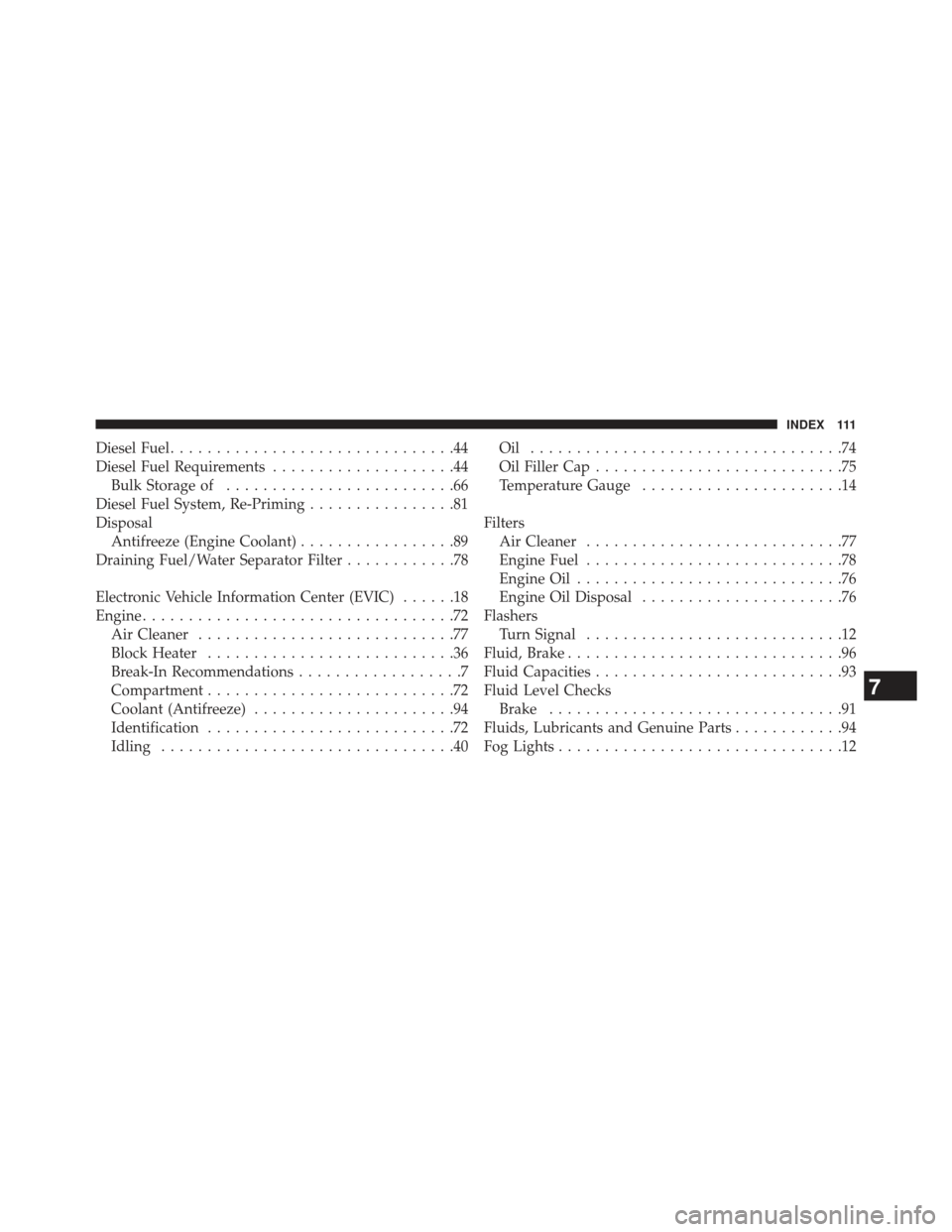Page 50 of 118

Fuel Water Separation — Must Use Mopar
Approved Fuel Filter Elements
Biodiesel fuel has a natural affinity to water and water
accelerates microbial growth. Your Mopar filtration sys-
tem is designed to provide adequate fuel water separa-
tion capabilities.
Fuel In Oil Dilution — Must Adhere To Required
Oil Change Interval
Fuel dilution of lubricating oil has been observed with
the use of Biodiesel fuel. Fuel in oil must not exceed 5%.
To ensure this limit is met your oil change interval must
be maintained with in the suggested schedule. The
regular use of biofuels greater than 5% and less than 20%
require intervals shorter than the outlined 10,000 miles
and must not exceed the suggested schedule. When
routinely operating on biofuels greater that 5% and less
than 20%, oil and filter replacement intervals must not
exceed 8,000 Miles or 6 months, which ever comes first.
Biodiesel Fuel Filter Change Intervals
The use of biofuels require intervals shorter than the
outlined 30,000 miles (48 280 km) and must not exceed
the suggested schedule. When operating on biofuels
greater that 5% and less than 20%, fuel filter replacement
intervals must not exceed 20,000 Miles (40 233 km).
NOTE:
Under no circumstances should oil change inter-
vals exceed 8,000 miles (12 875 km) or 6 months, if regular
operation occurs with greater than 5% and less than 20%
biodiesel blends. Under no circumstances should fuel filter
intervals exceed 20,000 miles (40 233 km), if regular
operation occurs with greater than 5% and less than 20%
biodiesel blends. Failure to comply with these Oil Change
and fuel filter requirements for vehicles operating on
biodiesel blends up to B20 may result in premature engine
wear. Such wear is not covered by the New Vehicle
Limited Warranty. The engine may suffer severe damage if
operated with concentrations of biodiesel higher than 20%.
48 STARTING AND OPERATING
Page 66 of 118
1 — Fuel Fill Location
2 — Diesel Exhaust Fluid Fill LocationNOTE:
There is no fuel filler cap. A flapper door inside
the filler pipe seals the system.
3. Insert the fuel nozzle fully into the filler pipe – the nozzle opens and holds the flapper door while refuel-
ing.
4. Fill the vehicle with fuel – when the fuel nozzle “clicks” or shuts off the fuel tank is full.
5. Remove the fuel nozzle and close the fuel door.
Emergency Fuel Can Refueling
Most fuel cans will not open the flapper door.
A funnel is provided to open the flapper door to allow
emergency refueling with a fuel can.
Fuel and Diesel Exhaust Fluid Fill Location
64 STARTING AND OPERATING
Page 70 of 118
Adding Diesel Exhaust Fluid
The DEF gauge (located on the Electronic Vehicle Infor-
mation Center (EVIC) display) will display the level of
DEF remaining in the tank. Refer to “Electronic Vehicle
Information Center (EVIC)” in “Understanding Your
Instrument Panel” for further information.
NOTE:Driving conditions (altitude, vehicle speed, load,
etc.) will effect the amount of DEF that is used in your
vehicle.
DEF Fill Procedure
NOTE: Refer to “Fluids, Lubricants, and Genuine Parts”
in “Maintaining Your Vehicle” for the correct fluid type. 1.
Remove cap from DEF fill inlet (located in fuel door).
1 — Fuel Fill Location
2 — Diesel Exhaust Fluid Fill Location
Fuel and Diesel Exhaust Fluid Fill Location
68 STARTING AND OPERATING
Page 73 of 118
MAINTAINING YOUR VEHICLE
CONTENTS
�ENGINE COMPARTMENT — 3.0L DIESEL .....72
� MAINTENANCE PROCEDURES ............73
▫ Engine Oil ...........................74
▫ Engine Air Cleaner Filter ................77
▫ Draining Fuel/Water Separator Filter ........78
▫ Underbody Mounted Fuel Filter Replacement . .80
▫ Priming If The Engine Has Run Out Of Fuel . . .81
▫ Intervention Regeneration Strategy —
EVIC Message Process Flow ..............83▫
Maintenance-Free Batteries ...............84
▫ Cooling System .......................84
▫ Charge Air Cooler — Inter-Cooler ..........90
▫ Brake System .........................91
� FLUID CAPACITIES .....................93
� FLUIDS, LUBRICANTS AND GENUINE
PARTS ...............................94
▫ Engine .............................94
▫ Chassis .............................96
5
Page 77 of 118

Checking the oil while the vehicle is on level ground will
improve the accuracy of the oil level readings. Add oil
only when the level on the dipstick is below the “MIN”
mark. The total capacity from the MIN mark to the MAX
mark is 1.7 qts (1.6L).
CAUTION!
Overfilling or underfilling the crankcase will cause
oil aeration or loss of oil pressure. This could damage
your engine.
NOTE: It is possible for your oil level to be slightly
higher than a previous check. This would be due to diesel
fuel that may temporarily be in the crankcase due to
operation of the diesel particulate filter regeneration
strategy. This fuel will evaporate out under normal
operation. Never operate the engine with oil level below the “MIN”
mark or above the upper “MAX” mark.
Change Engine Oil
Refer to the “Maintenance Schedule” for the proper
maintenance intervals.
Engine Oil Viscosity (SAE Grade)
CAUTION!
Your vehicle is equipped with an advanced technol-
ogy Diesel Engine and an emission device designed
to limit Diesel Particulate Emissions from being
released into the atmosphere. The durability of your
engine and life expectancy of this diesel particulate
filter emission device is highly dependent on the use
of the correct engine oil.
5
MAINTAINING YOUR VEHICLE 75
Page 95 of 118
FLUID CAPACITIES
U.S.Metric
Fuel (Approximate) 3.0L Diesel Engine 24.6 Gallons93.1 Liters
Diesel Exhaust Fluid Tank 8 Gallons30.3 Liters
Engine Oil With Filter
3.0 Liter Diesel Engine (SAE 5W-30 Synthetic, API Certified Low Ash) 8 Quarts
7.7 Liters
Cooling System
3.0L Turbo Diesel Engine
(MOPAR® Engine Coolant/
Antifreeze 10 Year/150,000 Mile
Formula OAT (Organic Additive Technology)) 12 Quarts
11.4 Liters
5
MAINTAINING YOUR VEHICLE 93
Page 112 of 118

Adding Engine Coolant (Antifreeze).............87
Adding Fuel ..............................63
Airbag Light .............................19
Air Cleaner, Engine (Engine Air Cleaner Filter) .....77
Antifreeze (Engine Coolant) ...................86
Capacities .............................93
Disposal ..............................89
Anti-Lock Warning Light .....................11
Automatic Transmission Fluid Type .............................96
Axle Fluid ...............................96
Battery .................................84
Brake Fluid ..............................96
Brake System .............................91
Fluid Check ............................91
Master Cylinder .........................91
Warning Light ..........................15 Capacities, Antifreeze (Engine Coolant)
...........93
Capacities, Fluid ...........................93
Caps, Filler Oil (Engine) ............................75
Radiator (Coolant Pressure) .................88
Charge Air Cooler .........................90
Coolant Pressure Cap (Radiator Cap) ............88
Cooling System ...........................84
Adding Coolant (Antifreeze) ................87
Coolant Capacity ........................93
Coolant Level ...........................85
Disposal of Used Coolant ..................89
Drain, Flush, and Refill ....................85
Points to Remember ......................89
Pressure Cap ...........................88
Radiator Cap ...........................88
Selection of Coolant (Antifreeze) .............86
110 INDEX
Page 113 of 118

Diesel Fuel...............................44
Diesel Fuel Requirements ....................44
Bulk Storage of .........................66
Diesel Fuel System, Re-Priming ................81
Disposal Antifreeze (Engine Coolant) .................89
Draining Fuel/Water Separator Filter ............78
Electronic Vehicle Information Center (EVIC) ......18
Engine ..................................72
Air Cleaner ............................77
Block Heater ...........................36
Break-In Recommendations ..................7
Compartment ...........................72
Coolant (Antifreeze) ......................94
Identification ...........................72
Idling ................................40 Oil ..................................74
Oil Filler Cap
...........................75
Temperature Gauge ......................14
Filters Air Cleaner ............................77
Engine Fuel ............................78
Engine Oil .............................76
Engine Oil Disposal ......................76
Flashers Turn Signal ............................12
Fluid, Brake ..............................96
Fluid Capacities ...........................93
Fluid Level Checks Brake ................................91
Fluids, Lubricants and Genuine Parts ............94
Fog Lights ...............................12
7
INDEX 111